#than the Fleischer Popeyes
Text
what a fantastic transition
#as much as i absolutely adore LT with all my heart there are no cartoons out there that give me such a CONSISTENT sense of raw visceral joy#than the Fleischer Popeyes#they are the epitome of fun. that’s such a vague word i know but i think it perfectly encapsulates these cartoons#not too gaudy or self absorbed. despite the fantastical nature of some plots and the gags and visuals there’s a down to earth humility as#well. it owns its simplicity very well. hearing that ‘30s jazz reach a climax as the visuals and gags and tactility and emotions get#stronger and faster in the climax of these shorts literally#gives me goosebumps! it’s an adrenaline rush#i also adore Olive Oyl. i mean i love them all. Bluto is the greatest cartoon asshole of all time. i love the nobility of Popeye. but i#really love that Olive gets to be just as loud and mean and weird and ‘ugly’ as the rest of the guys. she can throw a punch too. she’s not#just there to look pretty or be coquettish. she has a really natural charm and doesn’t feel forced like ‘oooo look at the cool LADY#participating too!’ which i feel is an issue with cartoons of both the past and present#she’s just another facet to these cartoons without calling much attention to herself and i really like that and wish there were more#like her#popeye#seasin’s greetinks#kneitel#vid#the lack of regular woman characters outside of thin tropes in golden age cartoons doesn’t bug me as much as it really should#because as a kid i was so used to watching ‘boy’ cartoons and connecting with ‘boy’ characters (i thought liking girl characters would make#me ‘girly’) and so it’s something i’ve always been sort of used to#but with that said Olive is one character i feel very strongly about and am glad she exists for those reasons#i don’t know why i’m getting so deep on this 10 second post? but anyway you should watch Popeye if you haven’t
219 notes
·
View notes
Note
Also, Popeye isn't anime. So don't say you're an otaku for an American cartoon. Popeye just might be the most American/patriotic cartoon of all time.
ya ijot! ya iggorant swab!! Popeye was on accouna where anime comed from!!! the Popeye comicks was a huge influinks on early Dragon Ball, an Goku is a very similar charaker. How the early Popeye shorts did action was a big influinks on a lotta shonen stuff. an anyway, the fleischer stuff in general was big for guys like Tezuka, as big or evin bigger than Disney was. Miyazaki hisself said the Popeye's were "firs rate!" Yer jus unedjimacatid!!
hav a Popeye sockin lighting for yer trubbles ya flool
79 notes
·
View notes
Text
Good Stuff: Unicorn Warriors Eternal
or How to Not Worry and Relish as the Enigma

I don't like to put famous creators on pedestals, the expectation can dwindle the moment you know they're noticeably fallible, but I'll say Genndy Tartakovsky has earned his keep. Killing it directing both banger shows and quality Adam Sandler movies, you could say Unicorn Warriors Eternal is a victory lap considering that was a project years in the making and Primal being successful enough for the network to have the unfathomable idea of giving it more than two seasons. But for UWE, this is the prime project for Genndy and now that it's out, does it soar like his previous works or does it feel like something's missing for it?

Just as good question: Can the Popeye movie have another chance too?
Unicorn I'll say has a good unique idea being a mix between high and low fantasy. We got dark magic, elves, and cosmic psychonauts taking place in a steampunk version of the UK. The main crew live beyond time and as Genndy puts it, any further season can be a jump into another period. The team themselves I feel come together as well as the trio from Sym-Bionic Titan. What I'm unfortunately going for is that there is good to be had, but the execution of things... I dunno, isn't as satisfying?
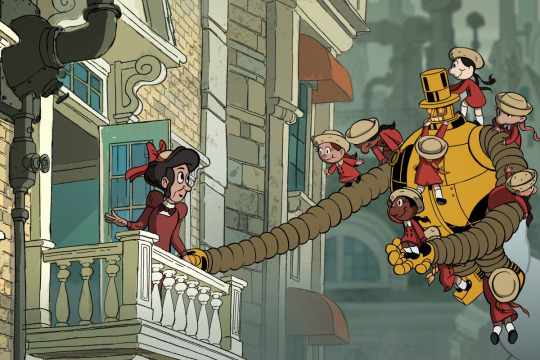
Except Copernicus. Literally the best.
I feel Genndy understands that there can exist consequences, but the main idea of throwing everlasting souls into still breathing humans is something I feel is not explored well. We grasp the struggle Emmelinda has with basically living as two people in one body, but nobody really concerns about how Alfie might've been feeling having the ability to feel eternity and infinity all at once or that Edred is more clear minded but can't read the room of the team not being on the same page as him. This being a supposed mini-series, things aren't allowed to simmer and beats that do you're just expected to accept when they immediately move on. I can remember Merlin acknowledging his notable negligence toward Melinda, but it didn't resonate as well as it could have. The kitsune exists for a few moments and then *POOF* were we meant to keep June Way in mind? Who knows? We get moments and revelations with hardly the satisfaction.

Winston's the one consistently good part of all this
I'm not saying Unicorn is bad with pacing, but it's an enigma figuring out the flow of the narrative as I felt it was spinning its wheels for half the show. They make up for it by having good characters and animation, it does have its endearing moments because I like Emma's journey, Winston is more of a chad than Edred, and it is just great seeing a fantasy action series for once. What hurts it I theorize is the episode limit. While Genndy of course had everything planned, ten did not feel like enough to have everything wangjangled well compared to the final season of Samurai Jack which had an ongoing narrative too. Fact that the longest episode was purely about exploring Edred's past tells me that this could've worked with either one more episode or a few more months with story revisions. I'm saying Unicorn could've been given better time to breathe while the quality of direction can remain the same. Otherwise, it's at least good seeing Genndy's dream project evolve and finally realized with the style he appreciates the most.

When other time am I gonna get badass Betty Boop?
I wanted to review this series before the finale to see how well this would turn out after finally premiering. One-half remained gleeful over the Tezuka and Fleischer influence that makes the blood of this show's visuals and the elements of action and character don't miss. This is Tartakovsky's project, through and through. The other half isn't calling this Genndy's all time greatest purely because it was his passion project because not everything clicked storywise. I would not binge this either, the week by week release kept the tension and intrigue better than I thought. Overall, I'm mixed. I recommend it definitely, but after Primal it isn't as jawdropping a banger as I hoped. I'm nonetheless happy Genndy finally got this off the ground, and if the finale promos are anything to go by this might be able to stay off the ground. Let the hope be strong, but I want to be honest and say...

7.5/10; Strong in style but rough in being resonating
#Unicorn Warriors Eternal#UWE#genndy tartakovsky#Cartoon Network#Adult Swim#cartoons#animation#reviews#Good Stuff
25 notes
·
View notes
Text
Rustic Rye Bread
From The Country Cousin in An Academy Award Review of Walt Disney Cartoons

History
So there's a bit of controversy around this short. It won the 1936 Oscar for best animated short, supposedly because of the character work where the main character acts drunk.
However that was also the same year that Fleischer Studios released Popeye the Sailor Meets Sindbad the Sailor.

The short was deemed notable for being a two reel cartoon. It was double the length of most shorts at the time and historians argue that it was a major step forward towards full length animated films.
The short, along with its two sequels, are in the public domain and can be viewed from the National Archives if you want to watch them.
Food
Okay, back to the recipe. The country cousin slips on some slices of bread after getting drunk on champagne. This bread looks more rustic than pre-sliced bread, and darker too, so I've chosen an old rye bread recipe from 1934.

Ingredients
420 g of cold water from the tap
275 g boiling water
300 g of rye starter
340 g of rye flour
260 g of wheat flour
11 g of salt. You can add more to your taste.
Cookware
Stand or hand mixer
Mixing bowl
Baking pan
Directions
Mix your starter with flour and water and let it ferment for about 5-6 hours at room temperature.
Reserve about 10% of required flour amount, then mix all dry ingredients apart from reserved flour.
Add required boiling water to dry ingredients in three stages mixing everything very fast to get rid of lumps and without letting your mixture to cool down excessively. Once mixed with all the water, wait for your scald to cool down a little.
Mix in 10% of flour you have reserved previously. Cover tightly, and let sit for a few hours till cool completely.
Mix your sourdough and scald, let the mixture ferment for 4 hours.
Add remaining ingredients to you scald and mix well until no dry spots left. If you’re making a single loaf, then shape straight away and let the dough proof for 50 minutes.
Kneed the dough in a stand mixer on low for 15 to 20 mins (or hand kneed if so desired) and then let proof a second time for another 50 mins.
Place dough into a greased loaf pan and bake at 210 degrees for about 45 to 60 mins.
Then take the loaf out of the pan and let it cool completely before serving.

Next up, more crackers.
#disney dishes#historical recipes#food history#disney history#disney#the country cousin#an academy award review of walt disney cartoons#rye bread
8 notes
·
View notes
Text

Robot Chicken #43: “Squaw Bury Shortcake” | August 19, 2007 - 11:30PM | S03E02
Sorry this is late. Friday nights are easy for me to miss. Sorry it missed Saturday Night’s deadline too; tumblr seemed to go down right as I was about to post it. Here it is roughly one day and one hour later than it should be.
Let’s just fucking do this: “Tiny’s Big Problem” is a sketch where a big fat guy on a superhero team that I barely recognize has to lose weight, and he does, and then the punchline is one of his teammates kills him out of jealousy. The fat guy absent-mindedly eating the cardboard that the microwave pizza comes on is a pretty solid fat joke, though.
“Masturbation MythBusters” doesn’t really make that much sense. They are Mythbusters but they have Ghostbusters proton packs and they suck up a child who is masturbating to bust the myth that he’ll go blind? What’s even supposed to be funny about this? Like, okay, sure, on some basic level the idea of Ghostbusters coming in and zapping a child for jacking off is funny, but the logic here isn’t even pleasingly tortured. Just make them be Ghostbusters and maybe the sperms have little ghosts that need to be busted!!
“Popeye Intervention” is about Popeye having an intervention for–what else?--heroin. I mean, spinach. Popeye is voiced by Dave Coulier (who also voiced “Tiny” in the other sketch). They put an old scratchy film effect over it, spitting in the face of the restoration work currently being done for the Fleischer Bros. cartoon film library.
“King of the Monsters” This is a parody of Training Day with Ethan Hawke, who voices Godzilla Jr. in this. I’ve never actually seen Training Day, but I know the line “King Kong ain’t got shit on me” which figures into the punchline of the sketch. It’s fine. I guess. I mean, I hated it, but it’s fine.
“Council of Evil Tables” A guy fights Tables. Pretty simple. I don’t hate it but: did I laugh? NO!
“Give a Mouse a Cookie” A mom tells her child a freaking ~tWiStEd~ version of “If You GIve a Mouse a Cookie”, where the Mouse is vampiric and world is nuked into oblivion as a desperate measure to stop the spread of vampires. Could this be a metaphor for the rampant spread of socialism and the mutually assured destruction it will cause? I don’t know! (By the way I’m not a socialist anymore, I’m just going back to being “just some guy”)
“Feel Lucky, Punk?” Is a pretty basic take-off of Dirty Harry asking a “punk” if he feels lucky, and he does! So he goes and has a very luck-luck-lucky crime spree. Seth Green calls this a bad sketch on the commentary. Don’t worry Seth, they are all bad. The wiki says a gag similar to this appeared on Family Guy. I should Family TRY to watch that.
“Bob Barker’s New Gig” is about Bob Barker retiring from Price is Right and becoming a vigilante castrator for stray (and not-so-stray) animals. Snoop Dogg plays himself, transforming from a dog to a human (reference to this music video). Bob sure does sound like Bob, but it’s a soundalike. Commentary reveals that they tried to get him to play himself but he passed… AWAY!!! Hahaha! No, actually, they make that joke on the commentary and he wasn’t dead yet. Sorry everyone. I stole from Robot Chicken. This sketch exemplifies the value of the original DVDs, because the DVD is vastly uncensored and the HBOMax versions are not. Good news for those of you wishing to see mangled stop-motion animal genitals.
Well, I guess I have to keep watching these for a while. Robot Chicken continues to get charitable bits of faint praise from me. What else is new.
EPHEMERA CORNER

Aqua Teen Hunger Force Colon Movie Film for Theaters DVD marathon (August 13, 2007)
The two-disc version of Aqua Teen Hunger Force Colon Movie Film for Theaters came out on DVD on Tuesday, August 14, 2007. But those who tuned in on Monday Night were treated to an Aqua Teen Hunger Force marathon with episodes interspersed with various things that appeared on the DVD. This included music videos, the “fake endings” and a bunch of other promotional stuff. The second disc of the DVD release contained the Deleted Movie which consisted of deleted material and– oh. FUCK. I promised to review that I’m pretty sure.
Okay, everyone. This post was a day late, so here’s a BONUS review of THE DELETED MOVIE:
Aqua Teen Hunger Force Colon Movie Film for Theaters: The Deleted Movie (August 14, 2007)
This was a more interesting watch than I thought it would be, and it’s also a vastly less enjoyable watch. This is an assembly of the movie using predominantly deleted scenes in an exceptionally less-produced state. That means segments from the “Deleted Scenes” episode which were animated fully (perhaps FOR the episode?), are seen here in a less-finished form. Scenes that play out like normal seem to sometimes get a cool alternate view, like the pencil test versions of animation that actually did wind up in the movie.
The story notably starts with the Dr. Weird scene; the one where he talks about his lair being turned into “fucking condos”. It follows the pattern of a typical Aqua Teen episode that way with it’s own Dr. Weird cold open. It goes from said Dr. Weird scene into the opening sequence that we see in the main movie, it just has a bad Dana Synder song playing over it instead. I sincerely wonder if they actually would have used this as the movie opener because it really sucks.
This version also misses the Egypt prologue as well as the “Let’s All Go Out to the Lobby” bit (and boy do I mean “misses them”). I’m not sure I really made this connection last time, but boy, does this movie ever feel like a sequel to Rabbot. The story is very Rabbot-esque, and it even includes an interlude where Shake ditches the mission at hand to undergo some sort of cosmetic conditioning. In Rabbot it’s getting his hair done. In this it’s getting a tan and teeth whitening.
This version is also less censored, and some Meatwad’s potty-mouth moments sorta delighted me, I’m not gonna lie. Also neat was seeing a bit in the middle that was just a filmed table-read; apparently there was supposed to be a live-action sequence with an early version of the Bible Fruits as an educational program that appeared on the ATHF TV. This was likely a nod to the puppet shows that Meatwad regularly enjoyed on the TV series. The Bible Fruits were going to be portrayed by actors in costumes, much like the Fruit of the Loom ads that probably no longer exist or are relevant.
A lot of alternate punchlines, and almost everything in the main movie is better. I can’t think of an example of a scene or jokes that were in here but I wished were in the main film. The movie itself had an alternate punchline: the entire thing turns out to be Meatwad playing with his dolls; like a St. Elsewhere-esque reveal. Meatwad actually has a cup with a crudely-drawn face on it; this was Shake. Dr. Weird turns out to be his father, and then the post-credits scene would’ve featured the same grotesque female Frylock we see in the post-credits scene of the actual movie. So he’s Meatwad’s mom, you see. That’s where the whole “Frylock is a woman” thing was supposed to go. It’s much less explained in the real movie.
I had hoped there was going to be a Dave and Matt commentary on this thing, bug I guess there’s not. The actual movie itself on DVD has a commentary track with Dana Snyder, Fred Armisen, Todd Hansen, and Patti Smith for some reason (she’s a big fan). Typically when you record the commentary track for a motion picture it comes off the tail end of finishing the movie, so the prospect of rewatching it yet again is probably not an attractive one.
Honestly, watching the Deleted Scenes episode is more fun than this, and this doesn’t offer much more than that episode. Sort of an interesting curiosity, but not that enjoyable to watch.
3 notes
·
View notes
Photo

TASK 001: MUTANT FUCKERY !
what is your ability?
fun lord with clown physiology
what is your character’s government-assigned classification level?
level four. she can essentially bend reality... and the past and the present, as long as it’s fun to any kind of third party. that said, at inspection, she does not look entirely human, but she’s far more passing than most level two.
what can you do?
use all silly powers, master cartoon physics ( fun lord is the highest form ), grow stronger through laughter, make people burst out into song, induce a party, attack with any weird forces, and fully control the plot ( amongst other things ).
however, before this... ‘i’m you but stronger’ side of her mutation was unlocked, she simply had clown physiology -- that said, she is a master of all powers related to that.
she’s a class act with hilarity, and definitely the power she has the most control over (otherwise her audiences would literally fucking die). she’s also very good at controlling the simpler ones – card generation, balloon manipulation, prank intuition, performance art intuition. and, although she no longer has much use for it, malleable anatomy and pain suppression are both skills. her final few years in kappa (or barnum depending on hf timeline) did her one favor: introduce her to the miming variation, thus meaning she can mime any action and thought waves will will it to happen in real life (such as miming a gun and shooting – if she wants to, it can actually have the same effects as an actual bullet). she has her own pocket dimension to keep weaponry – both real and gag – within. she is more bound to the laws of cartoon physics than she is to the laws of nature, thus making her very existence more... comical (for example, you best bet that if she got slammed through a wall, it would leave the perfect silhouette as opposed to a gaping hole). they don’t all apply to her, but... so many do...
and a few other things that are just silly and goofy and creepy! in addition, although not due to her mutation, very acrobatic – being part of a traveling troupe can do that! she can also technically leave clown form™, but why would she ever give up the powers just to look like someone who doesn’t make bold fashion statements? ALSO, lest we forget her alien mind… love it for her…
what can’t you do?
since she’s only had the fun lord fully unlocked for a few years, she has not nearly mastered those abilities. she’s always had a touch of cartoon physics, but things like manipulating logic ? creating paradoxes ? controlling the plot ? yeah, she’s got no fucking clue. ( for fun lord reference -- just because it sounds so broad, but... i would not choose a power that is broad over fun, think about the looney toons and fleischer brother cartoons (betty boop, popeye, koko the clown) and how they can completely manipulate their reality. there’s also this one toon i was shown in my animation class last year... so sad i can’t remember it, but the characters made the author change the plot. so fun stuff like that ! )
she’s generally good at not just fucking building bombs, but every now and again… a balloon will almost go ka-plow! rip :-( she’s also got a pretty immense fear of using her miming, but that… you know, stems from mutant caterpillar trauma… how they chopped off her limbs for that one to see if it was reality warping or she really did need to action it 😔
what are your weaknesses?
well, she always looks like a clown with one pink iris, so jot that down. ( that said, very lucky in that the clownery aesthetic lends more towards e-girl than it does ronald mcdonald. ) in addition, mentally blending in with the people who surround her is not very easy. it takes a lot of work to pretend to see the world in its real hues as opposed to some brilliant vibrancy, a la ‘ldn’ by icon lily allen. there are also some people who are just boring who her super fun powers won’t work on 🙄
then there are also all the fun lord powers, but you know...
how did you first come to the realization that you were a mutant?
she was born looking a little bit different, but it was chalked up to a kid with some human genetic defect. after suspicions increased, driven by weird-ass magic clown shit, she was shipped off to go live with some carnies and be their local clown ! then she told a not-funny-at-all joke that accidentally made half the audience literally laugh themselves to death :\ so like... that was confirmation...
as for fun lord, after extracting some of her dna to inject into kian to see what the hell happens, an upgraded mutation??? was unlocked. she was working beyond the realm of clownery, working beyond the realm of regular cartoon physics ( mastering them, instead ). there were times that she could swear... she was contacting her creator ! someone named may ! and, upon release, there were times that she would say any ‘i wish’-adjacent statement and... it might just happen. nothing grand scale, but she could say ‘i wish i had chosen rye instead of pita’ and history would rewrite itself.
if given the choice, would you remain a mutant? why or why not?
mhm ! can it be difficult ? for sure. has it presented a lot of obstacles and torture, whether the hf timeline keeps kappa or i move to an original affiliation ? yea :\ but the world must be a dull place...
what do you hope to see change in the future, with respect to the current strife over mutant acceptance? short-term? long-term?
some legit comeuppance. while she would never join the damned -- hierarchies and organizations just aren’t her thing! ( hf doesn’t count by reason of not being a group that relies on the standing of mutants... and by reason of being headed by january with her as the right-hand ) -- she does agree with the part of their cause that basically says: humans gotta take responsibility or get fucked! ( but so do mutants who helped :\ it’s so messie :\ )
#task !#luv that i've been playing jess long enough to see the superpower wikia shift the title from#'clown physiology' to 'archetype: clown'#ur still clown physiology to me <3
1 note
·
View note
Text
Max and Dave Fleischer Research
Max and Dave Fleischer founded the studio Fleischer studies in 1929, a studio which was responsible for characters such as Betty Boop, Bimbo, Popeye the Sailor and Koko the Clown. What made Fleischer Studios at the time stand out from Disney was that their popular cast of characters was mostly human rather than anthropomorphic animals. As well as that, their animations depicted grittier and more urban environments influenced by the Great Depression, as well as themes of sex and death, at least until the 1934 Hays Code censorship of films.
From 1918 to 1929, Max Fleischer created a series of silent films known as Out of the Inkwell to demonstrate his rotoscoping technique. This is also where Koko the Clown, or just "The Clown", as a character first appeared. During the production of Out of the Inkwell, Max and Dave Fleischer left the Bray Studio and founded their own studio.
Max Fleischer developed the technique of rotoscoping, which is when animation is made by tracing frame by frame over live action to create realistic movement. At its inception, live action footage would be projected onto a glass panel and traced onto paper. This projection equipment is known as the rotoscope.
0 notes
Text
Rotoscoping What is rotoscoping ? Rotoscope animation describes the process of creating animated sequences by tracing over live-action footage frame by frame. Though it can be time consuming, rotoscoping allows animators to create lifelike characters who move just like people in the real world. Some examples could be Walt Disney Studios had used rotoscoping for some animation movies such as Snow White and the Seven Dwarfs, Peter Pan and Cinderella in order to create realistic movements for otherwise stylized characters. The process was to film scenes with real actors and sets. Then, these images were used as references for the Disney animators to help them visualize the scenes, postures and movements to draw.
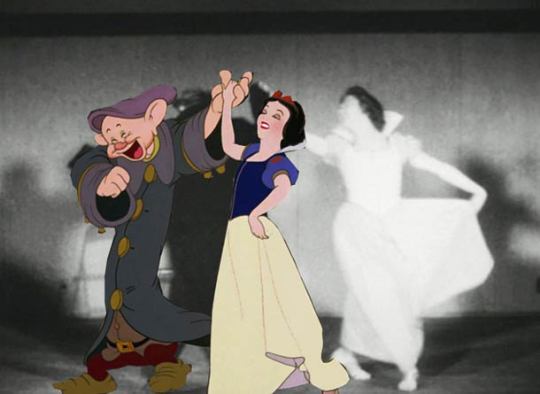
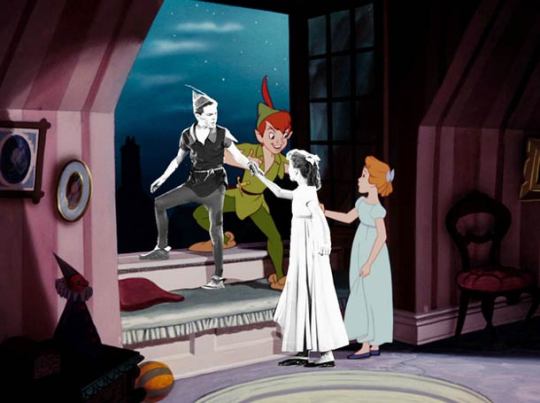
This type of anamton could never be bad it's a classic and Is apart of most of people's childhood it looks nostalgic and feels it when rewatching . I would of never guess that it used this technique to make it . Another example could be Cup head. How was Cuphead game animated?
By using the same animating tools and techniques that they did in the 1930s handdrawing and inking each frame animating on the ones, and creating hand painted watercolor backgrounds They believed they can closely replicate the 1930s style better than using modern and digital means to create the art .it's a reference to rotoscoping, an old animation technique invented and used by max fleischer (the dude who created popeye, betty boop etc) where you trace over live action film reel. so something like the illusion of 3d backgrounds found in popeye meets sinbad the sailor and the dance scene from the betty boop cartoon "the old man of the mountain" were all done thanks to that technique. studio mdhr deliberately tried to recreate that with the genie and dragon bosses but instead of using rotoscoping they just simply made a 3d model of a pyramid and a tower and photographed that from a bunch of different angles
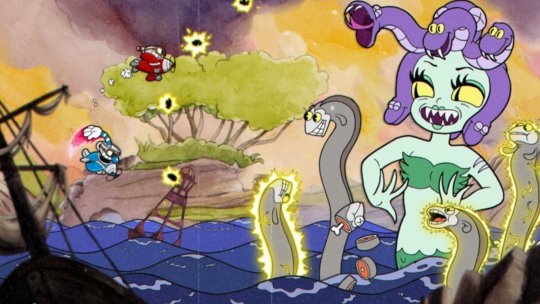

I love this type of animation style it's a interesting experience as I didn't grow up to this type of animation style the game did come out on the 29th of September 2017 so it was really cool seeing people playing this game in this style as most people haven't seen it or haven't seen it for a while. For players that appreciate classic run-and-gun combat, punishing difficulty, constantly learning from failure, and breathtaking experience cuphead will not disappoint.
0 notes
Text
Émile Cohl
Émile Cohl is one of the earliest pioneers of animation. Cohl goes down in history as the creator of what many cartoon historians consider the first genuine fully animated cartoon, 'Fantasmagorie' (1908). He was also the first to adapt a comic strip into a regular animated film series. Cohl was a well-known caricaturist in his day and also made a few comics himself.
He found a new pastime in the marionette theatres of Guignol and by working as a political caricaturist. During the Prussian siege of Paris, he was able to give local citizens much escapism through these occupations. Cohl worked as an apprentice for a jeweller and a maritime insurance broker before eventually working for a philatelist.
Legacy and influence
Émile Cohl enjoyed a long career in many different creative arts, but will always be remembered for his pioneering work in the field of animation. Whether as an animator of short films or a special effects-animator for live-action films, his work definitely broke new ground. Unfortunately many of Cohl's 300 films are lost today, but the ones that remain still prove a testament of his cinematographic accomplishments. He inspired early animators like Winsor McCay, Raoul Barré, John Randolph Bray and Paul Grimault, some of whom directly copied Cohl's ideas. Cohl lived to see the medium he helped give shape to being further developed into a genuine artistic movement. It was in gratitude for his contributions to animation that cartoonist Frick made an "in memoriam" cartoon featuring Walt Disney's Mickey Mouse and the Fleischer Brothers' Betty Boop and Popeye mourning over Cohl's death. Cohl's name lives on in a Parisian square, the academy École Émile Cohl and the annual animation award Prix Émile Cohl.

The animation style Cohl developed saw human figures changing into unexpected images which did away with notions of logical sequence or reality. He used puppets, drawings and cutouts among other objects to create more than 250 films within the period of 1908 and 1923.
The animation style Cohl developed saw human figures changing into unexpected images which did away with notions of logical sequence or reality. He used puppets, drawings and cut outs among other objects to create more than 250 films

0 notes
Text
An Animated Mind, High On Gear 5
As a fanatic for both Western animation and anime, more than one person in my every life.
I've more than once heard the comparison to Tom & Jerry, as it's the one the creator gave, which is interesting. Tom & Jerry animation didn't often look like that, but that's what Oda states as his primary reference so he would know (I really need to start reading the manga). At least when it comes to how Toei chose to animate it, what this really did remind me of was Fleischer, especially that "fluid noodle people" reference, and it's a shame that's not an name on people's lips more regarding this. This is pretty much exactly how I would imagine an anime Popeye adaptation would look when it really got going.
With a little bit extra: Gear 5 is like a glorious mix of Fleischer and Tex Avery with classic shounen (One Piece being one of the last examples, design wise, of a very strong traditional artistic style), and it's wonderful.
Which actually leads me to single animator and era this kept reminding me the most of. Crazy as it is to say, the whole time I was thinking of John K, and late 80's animation in general. That drive to merge classic animation designs and styles with modern animation techniques was pretty much the font of up and coming animators during that time, and when there was a serious budget behind it?
And also Richard Williams, because I'm like 80% sure there was a bit in that sequence (the part where Kaido gets burnt up) that was directly inspired by the Thief and the Cobbler. Actually, I'm changing my answer of "being reminded the most of." The more I remember of Richard Williams' work, the more this feels at least in part like a love letter to one the masters, Williams included.
I'm hearing about people giving the animation choices crap just because of what it chose to reference, which imo is silly. As if watching, loving, being amazed and learning from all the animation you can and being driven to build new and astounding things on top of it hasn't been the origin story of nearly every animator all over the world. Are anime fans really still out here seriously believing that there's only one region in the world anyone who's anybody actually pays attention to?
Because the people who actually make anime and manga have never, ever believed that. Art is universal.
#gear 5 luffy#gear 5th#monkey d. luffy#Eiichiro Oda#Megumi Ishitani#tex avery#fleischer studios#tom & jerry#luffy meets popeye when?#no not a versus battle thats weaksauce#john kricfalusi#richard williams#watch the thief and the cobbler people#toei animation#so this is where all of toei's animation budget goes#anime#animation#animatedmindsforanimatedtimes
1 note
·
View note
Text
TRI 1-2000 word essay
Updated: Dec 3, 2022
Max Fleischer and his animation style
Most people have watched or seen clips to do with 1930s animation like Betty boop. Betty boop was a popular series in the 1930s with the main character Betty Boop who was always featured in all the 90 cartoons for 9 years. The series is a jazz era flapper who is appeared in the roll of Snow White, who’s evil stepmother orders her to be killed by the recurring Betty boop characters, Koko and Bimbo. Betty was first featured in the first series, Dizzy Dishes in 1930. Through the creator of Betty boop. Max Fleischer, told his artists he wanted a caricature of the singer Helen Kane. Unfortunately Clara Bow was the one often given credit for inspiration. Keane sued Fleischer for using her signature “Boop-a-Doop” line. It’s unfortunate that Betty boop was seen in animation as a “sexual” woman who regularly wore a short dress, high heels and a garter belt and was seen as an “object of affection” to many men. Her cartoons were often considered to be risqué and very heavy on the sexual innuendos. But towards the end, the animators toned down her appearance. She was reinvented as and husband less housewife, her backless dress was replaced with a much longer dress with sleeves and a collar, her garter belt was never seen again and from then, Betty was portrayed as a schoolteacher, secretary and babysitter and was not much a nightclub singer.

The creator of Betty boop was an American animator, Max Fleischer who was head and founder of Fleischer studios along with his brother, Dave Fleischer. They brought other characters along with Betty, such as Popeye, Koko the clown and Superman. Fleischer’s Koko the clown who was merely the guinea pig who was meant to demonstrate an invention called the rotoscope, Which enabled an artist to trace the movements of an actual person frame by frame. The results were “incredibly lifelike” animation because it was akin from real life. The Fleischer studios were the first to use sound before any other company in the animation business. Fleischer also used the rotoscope which he invented which was a method to get smoother animation. When people think of animated cartoons, Walt Disney is the first to come in mind for most people. But there was a time where Max Fleischer was just as or even more famous than Walt Disney. Max Fleischer has been called “the unsung hero of animation” for his artistic and technical innovations with cinema. It was actually shown that the character Betty boop was an anthropomorphic canine character who sang, danced and wagged her dog ears. A year later, she became a fully human female animated character, with her big ears transitioning as big hoop earrings. Unlike the other female characters during her time such as Minnie Mouse and Olive Oyl, Betty was not a supporting role, she was a strong female character in her own right. The cartoon of Betty boop illustrates some human features which are sometimes labelled as “neotenus” such as the large head, short arms and legs, relative to total height and “clumsy child-like features”

Fleischer has the same animation style that he has used in all his animations. This style is known as The Rubber hose style which is has inspired my art work and style, rubber hose animation was first ever animation to be standardised in the American field. The defining feature is the curving motion most things possess, resembling that of a rubber hose. While the style fell out of fashion in the 1930s, there has been a revitalisation of it in the recent years. With works such as the famous video game, Cuphead, Bendy and the ink machine and in the movie of Steven Universe. Felix the cat was the first ever character-driven series of animated cartoons, began as Feline Follies in 1919 becoming very popular in the 1920s. The Felix cartoons faltered financially in the 1930s because of poor economic times but also because of legal ownership rights. But Felix the cat did come back in fashion and is featured on a variety of merchandise from clothes to toys. Other recent cartoon shows that show the use of this style is Mickey Mouse and even today, still has that rubber hose effect with the use of Toon Boom and Flash Animation. Even in the show Pingu, has techniques incorporated in its animation such as having characters have all their upper body stretch to reach up or roll into a ball. Sonic the Hedgehog also had rubber limbs, especially in the games in the 90s. An example of his rubber hose limbs is evident in his trademark pose with one hand on his hip, a waving finger and crossed legs seen on the art box of the original game and uses some exaggerated running poses. Because rubber hose has made a leap from newspaper to comic strips. They share a visual identity. Think heavy of use of black inks on white backgrounds and exaggerated facial expressions. As the comics with the animation that defining characteristic was added, flailing rubber hose limbs without joints. Other features of characters included in ink blot cartoons include white gloves, purely so animations could decipher characters hand movements in front of their black bodies. Most of these character had black noses and and pie eyes with one part sliced out. The arms and legs are the most important in rubber hose as they accentuate character movement and emotion. Wether its in a human or animal.
The characters would bounce around mostly in time to a Jazz soundtrack. This genre of music was extremely popular in the 1930s and originated in the African-American communities of New Orleans, Louisiana in the late 19th and early 20th century. Since the Jazz age, it has been recognised as a major form of musical expression in traditional and popular music. It’s characterised by swing and blue notes. Jazz has roots in European harmony and African rhythmic rituals. One of the most influential in this genre was Louis Armstrong with his career spanning 5 decades and several eras in the history of Jazz.
Now going back to the way rubber animation is shown is each deliberate movement is expressed in the squash and stretch principle. Oswald the rabbit trying to stay on a horse is a good example with the various “bow-legged bandy” movements. The rubber hose style brought out but necessity allowed more creativity. Animations took full advantage of the “freedom is allowed” and animated with the mindset of that in a cartoon, anything is possible. Another aspect of rubber hose animation is its reference to dark subject matter so many memorable cartoons at that time were characterised by how they portrayed mortality. Even some studios like Disney had no problem getting involved with cartoons that showcased hell, giving “surreal, creepy borderline terrifying” imagery after all, the rubber hose animation is roosted in the great depression and looking at the setting and the backgrounds makes this very apparent and without any censorship, animators were able to spill out on a page exactly how they felt. I like the fact that rubber hose animation has come back in fashion because when it comes to character art, I like seeing the exaggeration and different facial expressions on a character. Many artists that I follow have a similar art style to mine from the use of colour to the link of rubber hose style.
Many of those artists are inspired by Studio MDHR’s Cuphead. The game Cuphead plays beautiful homage to the cartoons from the 1920’s to 1940’s in such a “convincing” and “painstakingly sincere” style that almost convinces people that it was something taken straight out from that era. From the colour to the dust and scratches on the screen. The reason why it looks so authentic is because all of the designers used traditional animation techniques to achieve the style. The characters were all drawn on traditional work stations and Avon separate pieces of paper using the early animation technique. However, the way Studio MDHR transferred their drawings onto screen was different. They would scan all of the drawings one by one and cleaned them up then coloured them digitally. The clearest influence for Cuphead has always been Max Fleischer’s artworks and animations which means the characters are always going to be moving in some way. Even when still.
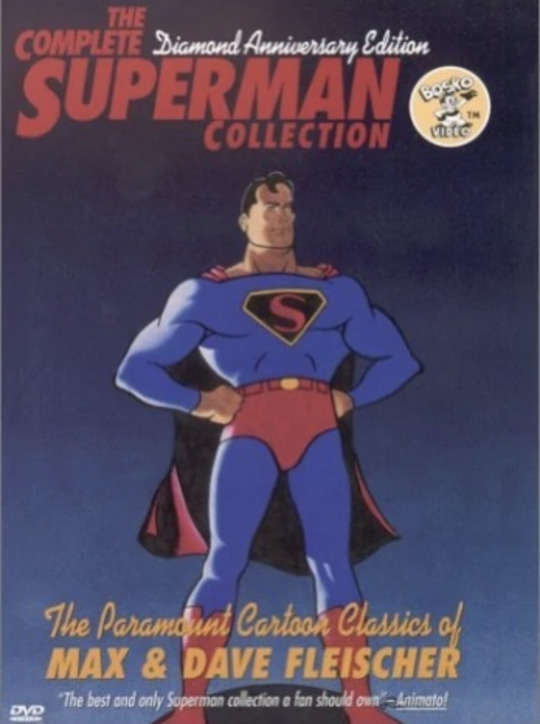
Cartoons from the 1930s to 1940s reflected their conflict between humans and the natural world. Perhaps as a reaction to World War II. However, superheroes like Superman, fought natural elements and won. This is suggesting that the World War has just as much of an impact on cartoons as Hollywood films such as Film Noir and Screwball comedies. The Superman series also by Max Fleischer, from this period, seems to reflect the impact most visibly. In this series, everyone seems to place Superman as superior to the elements of the natural world. In the opening to most cartoon shows from then to now, Superman masters lightning and other elements. In one of the episodes, Superman stops a volcanic eruption to save Lois Lane and the rest of the town members. “Superman always comes out victorious, an argument in favour of our allies own victory over the Germans.” Norman Klein says. From 1942 to the end of the war, half the cartoons produced were war related and that some studios for a time the proportions ran as high as 70%. The war provided the industrial background modernist in which technology and humans “triumph over nature”.
Cartoons from the 1930’s were ushered in by major political and economic crisis that were the remains of the World War I. However, there has been many cartoons that have been called out and even cancelled for racism. Even though they were made decades ago, people are still finding them today and calling them out for it. Some of these cartoons brainwashed children from a young age and taught them how to basically not accept other races and to not get along. These were mainly cartoons from the Golden age. Some of these racist cartoons included hate towards Japanese and Germans because of the war. But most of the cartoons were hate directed at black people. These characters in the show looked like blackface minstrels for a reason. Minstrel shows fundamentally shaped the history and language of animation. The live minstrel shows started in the early 19th century in America, where white people would blackface by using makeup and pretended to be caricatures of black slaves. These shows lasted till the late 20th century believe it or not. It’s shocking to me that it lasted that long. Many of the “minstrel” characters had black bodies and faces with big white lips and eyes. Now that times have changed, many cartoons include characters from all races to show kids that everyone should be treated equal and with respect no matter where they come from or what their background is.

Overall, I am still inspired by Max Fleischer and the rubber hose art style. I have been inspired since college and even made an animation in the rubber hose art style for one of my projects. This style has been an inspiration for many other artists and films and I also like the fact that this style is slowly coming back into fashion along with 2D animation since the release of the game Cuphead.
References:
https://youtu.be/O8p3MmCrNQk
https://youtu.be/MBo3ghPMJmE
0 notes
Text
Opportunities for Roto Artists' Careers
Rotoscoping is one of the first methods of animation that enables the creation of realistic video. Animation artists used to trace over movie footage frame by frame. Even though the technique is identical, it serves a different purpose in the visual effects sector. If you are an artist who wants to see their work on the big screen, VFX courses in Pune are a viable career choice for you. You can work on high-stakes projects, collaborate with leading studios, and ascend the corporate ladder to lead talented VFX Artist teams.
Rotoscoping is primarily employed today to produce a matte or mask for an element so that it can be detached and placed on a new background. It might even be disguised to change colors or for any number of other purposes. More people utilize it than you would think. Filmmakers can use rotoscoping to create situations that would be difficult, costly, or dangerous to make in real life.
Continue reading to learn more about the sectors that hire qualified, experienced, and certified rotoscoping artists for a range of positions.
VFX facilities
In larger VFX studios, rotoscoping artists are occasionally assigned to a project with a compositor or 2D lead to serve as their project manager. If not on one particular show, then on other shows that the company is in control of. When working as a Junior Compositor and handling their own roto and prep work in addition to the compositing process, roto artists in smaller organizations gain experience.
Houses that produce movies
Making a movie involves more factors than you can possibly fathom. Film production facilities frequently need rotoscoping artists. They do a simple task like tracing an actor's head's hair. Even with the availability of cutting-edge digital technologies, the Guardians of the Galaxy filmmakers relied on classic rotoscoping methods to bring 'Rocket' to life by using footage of a real racoon named Oreo.
Animation Studios
When animating Popeye the Sailor and Betty the Boop in 1914, the renowned director Max Fleischer pioneered the rotoscope technique. Disney used the footage rather than tracing over the live-action footage a few years later to obtain a sense of how a figure moved. Over the years, a lot of animators have developed their unique rotoscoping techniques. and is still employed to produce numerous animated assets.
Gaming businesses
Digital rotoscoping was created by game designer Jordan Mechner of Smoking Car Productions while working on the adventure game The Last Express. Even his earlier video game projects, Prince of Persia and Karateka, utilized rotoscoping. Since that time, the gaming business has consistently been a significant market where rotoscoping artists can pursue a profession.
0 notes
Text
Opportunities for Roto Artists' Careers
The opportunities for VFX artists in the video game industry are essentially limitless. Nearly every game you can imagine now includes visual effects, and numerous firms worldwide are on the lookout for skilled artists. Students learn how to alter images on the screen to produce effects that aren't feasible to shoot in real life in vfx classes in Pune.
One of the first methods of animation that enables the creation of realistic video is rotoscoping. Animation artists used to trace movie footage frame by frame. Even though the technique is identical, it serves a different purpose in the visual effects sector.
To produce a matte or mask for an element so that it can be detached and placed on a new background, rotoscoping is primarily employed today. It might even be disguised to change colors or for any number of other purposes. More people utilize it than you would think. Filmmakers can use rotoscoping to create situations that would be difficult, costly, or dangerous to make in real life.
Continue reading to learn more about the sectors that hire qualified, experienced, and certified rotoscoping artists for a range of positions.
VFX studios
In larger VFX studios, rotoscoping artists are occasionally assigned to a project with a compositor or 2D lead to serve as their project manager. If not on one particular show, then on other shows that the company is in control of. When working as a Junior Compositor and handling their own roto and prep work in addition to the compositing process, roto artists in smaller organizations gain experience.
Film production facilities
The process of developing a movie involves more factors than you can possibly fathom. Film production facilities frequently need rotoscoping artists. They perform tasks as basic as tracking an actor's head hair. Even with the availability of cutting-edge digital technologies, the Guardians of the Galaxy filmmakers relied on classic rotoscoping methods to bring 'Rocket' to life by using footage of a real raccoon named Oreo.
Animation Studios
When animating Popeye the Sailor and Betty the Boop in 1914, the renowned director Max Fleischer pioneered the rotoscope technique. Disney used the footage rather than tracing over the live-action footage a few years later to obtain a sense of how a figure moved. Over the years, a lot of animators have developed their unique rotoscoping techniques. and is still employed to produce numerous animated assets.
Gaming businesses
Digital rotoscoping was developed by Smoking Car Productions' Jordan Mechner while working on the adventure game The Last Express. Even his earlier video game projects, Prince of Persia and Karateka, utilized rotoscoping. Since that time, the gaming business has consistently been a significant market where rotoscoping artists can pursue a profession.
There is a tremendous need for skilled roto artists because rotoscoping is still a crucial step in the production pipeline for animated and live-action movies. You can get recruited by some of the top businesses in the aforementioned fields by completing a career course and acquiring the necessary skills.
0 notes
Text
Cartoon: Popeye Gopher Spinach, 1954
Cartoon: Popeye Gopher Spinach, 1954
Popeye the Sailor is an American animated series of short films based on the Popeye comic strip character created by E. C. Segar. In 1933, Max and Dave Fleischer’s Fleischer Studios adapted Segar’s characters into a series of theatrical cartoon shorts for Paramount Pictures. The plotlines in the animated cartoons tended to be simpler than those presented in the comic strips, and the characters…

View On WordPress
1 note
·
View note
Text
Every friend group should include a bimbo,

a mean bisexual,
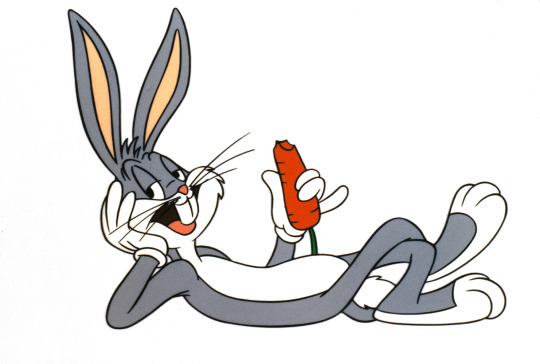
an even meaner lesbian,
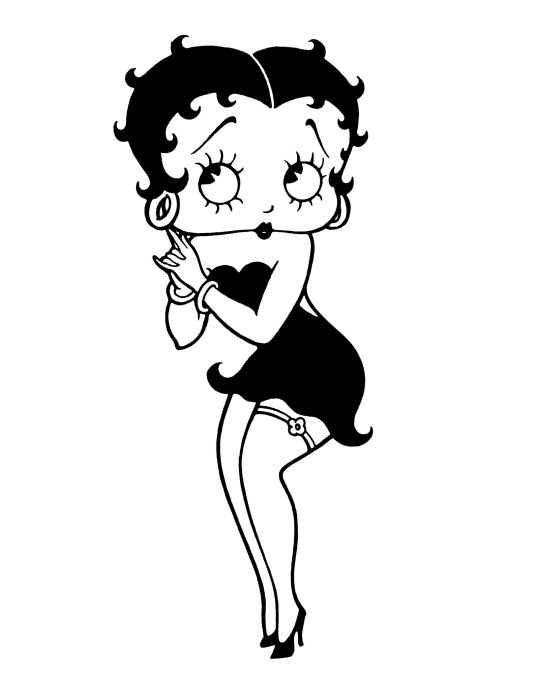
she/theyhims
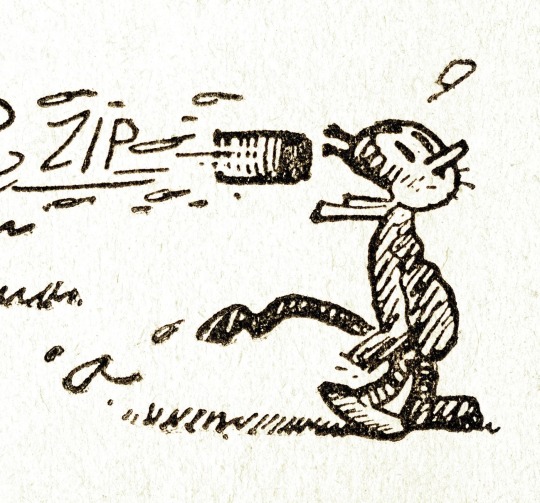
and he/theys,
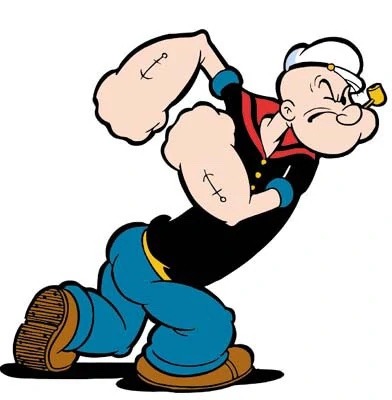
a token straight that’s on thin ice,

an astrology bitch who has everyone’s birth chart memorized,
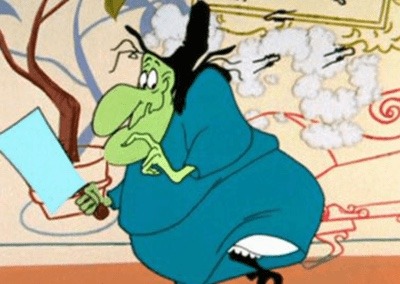
and a short king.
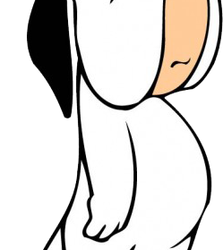
#meme#old cartoons#classic cartoons#fleischer bimbo#fleischer studios#looney tunes#bugs bunny#betty boop#krazy kat#popeye the sailor man#mickey mouse#classic disney shorts#looney tunes witch hazel#droopy tex avery#i don’t know if it’s really fair to call betty boop meaner than bugs bunny but she certainly won’t stand for any shit#roll the bones#cartoons
121 notes
·
View notes
Text

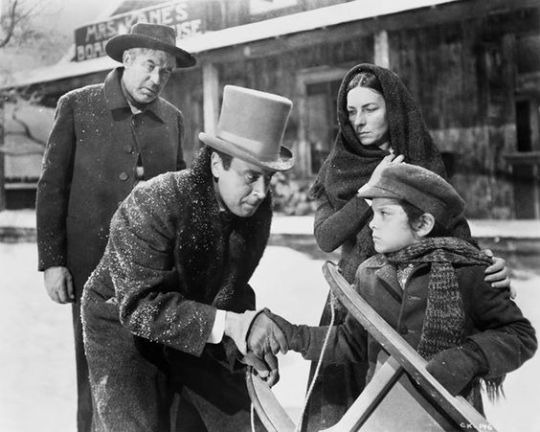
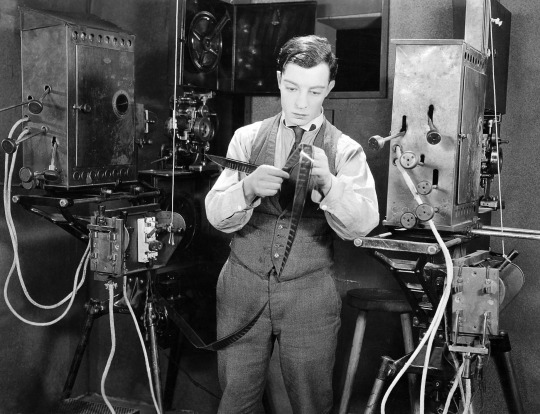

It's almost October (can you believe it?), which means it's the season for scary movies on TCM. Things start out on Friday, Oct. 1 with a daytime lineup of pre-code horror. We'll be DVRing director Fritz Lang's influential German film, The Testament of Dr. Mabuse (1933) airing at 10:30 am ET/7:30 am PT, but there's also a lot of old Hollywood favorites, including The Most Dangerous Game (1932) at 8 am ET/5 am PT and Mystery of the Wax Museum (1933) at 3:45 pm ET/12:45 pm PT.
Sunday nights in October will also feature horror films. Director Alfred Hitchcock's thriller The Birds (1963) at 8 pm ET/5 pm PT will be part of a night of creature features.
Here's the best of the rest for the week of Sept. 27, 2021:
1. Citizen Kane (1941) at 8 pm ET/5 pm PT Monday, Sept. 27: Writer/director/star Orson Welles' masterpiece about a newspaper mogul is part of a night of programming featuring the new Academy Museum in Los Angeles. There's something more than a hope that viewers will get a gander at the world's most famous sled before the evening is over.
2. National Silent Movie Day on Wednesday, Sept. 29: Honestly, you couldn't go wrong DVRing everything during this daylong celebration of the artistry of silent films (if you're interested here's a link to the complete September schedule https://www.tcm.com/schedule-monthly...) but we'll point you to the sublime tragic beauty of Maria Falconetti in The Passion of Joan of Arc (1927) at 2 pm ET/11 am PT and the sublime comic beauty of Buster Keaton in Sherlock, Jr. (1924) at 1:15 am ET/10:15 pm PT. The documentaries airing include Be Natural (2018) at 9:45 pm ET/6:45 pm PT a tribute to pioneering female filmmaker Alice Guy-Blache.
3. An Affair to Remember (1957) at 8 pm ET/5 pm PT Thursday, Sept. 30: This all-time great romantic weepie starring Cary Grant and Deborah Kerr is a great way to wrap up September. An Affair to Remember is part of a daylong lineup celebrating the centenary of Scottish actor Deborah Kerr, who was born Sept. 30, 1921, in Glasgow.
4. Fleischer Animation 100th Anniversary-Part 2 at 10:45 pm ET/7:45 pm PT Saturday, Oct. 2: This compilation of cartoons from the famed Fleischer Studios includes Saturday matinee favorites like Betty Boop and Popeye. Here's a link with more info: https://www.animationmagazine.net/.../tcm-celebrates.../
#TCM#TCM picks#TCM party#old Hollywood horror#horror#old hollywood#alfred hitchcock#Hitchcock#academy museum#national silent movie day#silent movies#deborah kerr#centenary#classic movies
42 notes
·
View notes